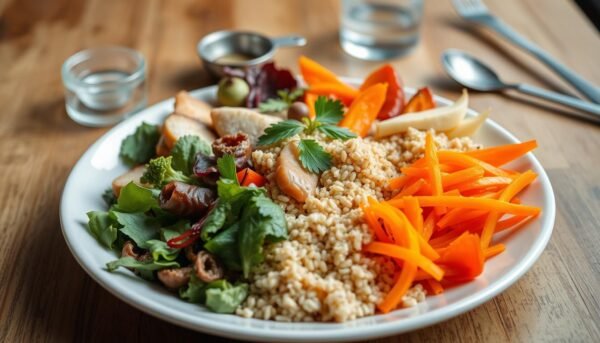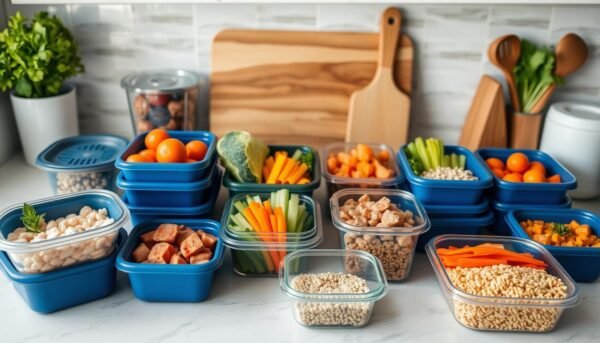Looking at the scale made my heart drop. I had let my health slide, and it hit me hard. I knew I had to change, and I wanted to do it right. I was determined to lose weight safely and effectively in 3 months.
Weight loss is more than just fitting into jeans. It’s about getting our energy and confidence back. The secret to success is understanding healthy weight loss and making a plan that fits you. Let’s explore how to transform your weight loss journey.
Understanding Safe and Sustainable Weight Loss Goals

Setting the right weight loss goals is key. Aim for losing 1 to 2 pounds a week. This pace is safe and healthy, helping you lose fat without harming your health.
Setting Realistic Monthly Weight Loss Targets
Start with losing 5% of your current weight. For example, if you weigh 180 pounds, aim to lose 9 pounds. Break this down into monthly goals for a successful weight loss journey.
The Science Behind Healthy Weight Loss
To lose weight sustainably, create a calorie deficit of 500 to 750 calories daily. This can be done by eating healthy and exercising regularly. Remember, your weight loss pace can vary based on age, genetics, and sex.
Factors Affecting Weight Loss Progress
- Age: Metabolism slows down with age, making weight loss harder.
- Genetics: Some people are more prone to weight gain due to their genes.
- Sex: Men usually lose weight faster than women because of muscle and hormone differences.
Despite these factors, setting realistic targets and focusing on sustainable weight loss is crucial. With patience, dedication, and a healthy lifestyle, you can reach your weight loss goals and enhance your well-being.
| Recommended Weekly Weight Loss | Recommended Monthly Weight Loss |
|---|---|
| 1 to 2 pounds (0.5 to 1 kilogram) | 4 to 8 pounds (2 to 4 kilograms) |
Preparing for Your Weight Loss Journey
Before starting your weight loss journey, take a few important steps. First, talk to a healthcare professional like a doctor or dietitian. They can give you advice on safe and lasting weight loss. They’ll also help you set goals that are right for you.
Next, figure out how many calories you need each day. This info is key for a diet plan that helps you lose weight. Use online tools or talk to a nutrition expert to find out how many calories you should eat. This depends on your age, gender, how active you are, and how fast you want to lose weight.
For good nutrition advice, eat lean proteins, fruits, veggies, and whole grains. These foods make you feel full and give you important nutrients. Also, eat healthy snacks and drink lots of water all day.
Keeping a food journal can also help. Writing down what you eat can make you more aware of your habits. It helps you see where you can do better. This can really help you reach your weight loss goals.
By doing these things, you’re ready for a successful weight loss journey. Remember, with the right mindset, hard work, and advice tailored to you, you can reach your goals. This will make you healthier and happier.
Creating Your Best Diet Plan for Optimal Results

Creating a diet plan that fits your life and tastes is key for losing weight. Focus on foods rich in nutrients and balance your macronutrients. Women should aim for 46 grams of protein daily, while men should aim for 56 grams.
Make sure half your plate is fruits and veggies. This variety is important for a healthy diet.
Calculating Your Daily Caloric Needs
To find your daily calorie goal, think about your age, gender, activity level, and weight. Use online tools or talk to a dietitian to set a safe calorie target. This target should help you lose 1-2 pounds a week.
Counting calories is helpful, but remember to eat quality foods too.
Macronutrient Distribution for Weight Loss
For weight loss, balance is key. Eat a mix of protein, carbs, and healthy fats. This balance keeps you full and healthy.
Meal Timing and Portion Control
Watch your portion sizes and avoid saying some foods are off-limits. Focus on eating in moderation. Also, think about when you eat. Planning meals can help control hunger and cravings.
Try different eating plans like intermittent fasting or eating small meals often. Find what works for you.
With a balanced diet plan, you’re on your way to losing weight safely. Remember, losing weight takes time and effort. Stay consistent and patient. With the right plan, you can achieve a healthier, happier life.
Essential Nutrients and Foods for Weight Loss Success

Weight loss isn’t just about eating less. It’s about eating foods that are good for you. These foods should make you feel full and help your gut. Let’s look at some great foods for losing weight.
Green tea is a great drink for losing weight. It has antioxidants and helps burn fat. Berries like blueberries and raspberries are also good. They’re full of fiber and vitamins that make you feel full.
Artichokes, kimchi, nuts, and seeds are also good for weight loss. Artichokes have lots of fiber. Kimchi helps your gut. Nuts and seeds give you healthy fats and protein.
Avocados, whole grains, and lentils are also great. Avocados have healthy fats. Whole grains like quinoa help control blood sugar. Lentils are full of protein and fiber.
Remember, losing weight is about eating the right foods. These foods help you stay healthy and lose weight. Eating these foods will help you on your weight loss journey.
| Weight Loss Food | Nutrient Benefits |
|---|---|
| Green Tea | Antioxidants, Boosts Metabolism |
| Berries | Fiber, Vitamins, Antioxidants |
| Artichokes | Fiber, Promotes Fullness |
| Kimchi | Probiotics, Gut Health |
| Nuts and Seeds | Healthy Fats, Protein, Fiber |
| Avocados | Monounsaturated Fats, Anti-Inflammatory |
| Whole Grains | Fiber, Regulates Blood Sugar |
| Lentils | Plant-Based Protein, Fiber |
Incorporating Exercise into Your Three-Month Plan

To lose weight in three months, mix cardio and strength training. Cardio burns fat, while strength training tones your body. This mix will help you see big changes.
Cardio Workouts for Fat Burning
Walking, jogging, swimming, or biking are great for burning calories. Try to do at least 150 minutes of these activities each week. High-intensity interval training (HIIT) is also good. It mixes intense exercise with rest to keep your heart rate up.
Strength Training Benefits
Strength training is key in your three-month plan. It helps build muscle, which boosts your metabolism. This means you burn more calories, even when you’re not working out. Make sure to include strength training 1-2 times a week, focusing on all major muscle groups.
Weekly Exercise Schedule
Make a weekly exercise plan to stay on track. Working with a personal trainer can help tailor a workout plan that fits you. A good routine might include:
- 3-4 days of moderate-intensity cardio (e.g., brisk walking, cycling, swimming)
- 2-3 days of strength training (e.g., weightlifting, resistance band exercises)
- 1-2 days of active recovery (e.g., yoga, stretching, light hiking)
Always listen to your body and rest when needed. Sticking to this plan will help you reach your weight loss goals in three months.
Meal Planning and Prep Strategies

Meal planning and prep are key for losing weight. Spend time each week planning and prepping meals. This helps you stay on track and avoid bad food choices when you’re tired or hungry.
Save your favorite healthy recipes for easy use. This makes meal prep easier.
Make meals ahead of time, like overnight oats or grain bowls. This gives you healthy options all week. It saves time and helps you eat better.
Talking to a registered dietitian can help. They can give you meal ideas and plans that fit your needs.
- Meal prepping saves time by creating time-saving opportunities during the week.
- Meal prepping reduces decision fatigue by minimizing the number of choices needed each day for meals.
- Meal prepping helps in reducing food waste and ensures buying only necessary food items, thereby saving money.
- Meal prepping encourages consistent eating times, which can help control hunger levels and prevent overeating.
Choose days like Sundays or Wednesdays for meal prepping. Pick days that fit your schedule.
Use mason jars for salads to keep them fresh. Store sauces in smaller containers.
| Meal Prepping Approach | Benefits |
|---|---|
| Individual Portioning | Simplifies portion control and ensures daily calorie targets are met. |
| Batch Cooking | Saves time by preparing large quantities of meals in advance. |
| Ingredient Prepping | Streamlines meal assembly during the week by having key components ready. |
| Freezer Meals | Provides quick, healthy meal options on days when cooking is not an option. |
Prepped foods last three to four days in the fridge. Use airtight containers. Freeze extra meals for quick options.
Change up your meals to avoid boredom. Choose foods you like and mix up ingredients and flavors.
Understanding the Role of Hydration and Sleep

Drinking enough water and getting good sleep are key for losing weight. Hydration and sleep quality play a big role in your weight loss journey.
Daily Water Intake Guidelines
Try to drink 64 oz or 8 glasses of clear, sugar-free liquids every day. Drinking enough water helps with weight loss by stopping hunger caused by thirst. Stay away from sugary drinks, as they add a lot of calories.
Sleep Quality and Weight Loss Connection
Getting enough sleep is as important as eating right and exercising for weight loss. Not sleeping well can mess with your hormones and metabolism, making it harder to lose weight. Foods like tart cherry juice, kiwi, fish, and dairy can help you sleep better.
But, diets that are low in fiber or high in fat or sugar can make it hard to sleep well. Try to avoid caffeine, alcohol, and fatty or sugary foods before bed. This can help you sleep better and longer.
Tracking Progress and Making Adjustments

Tracking your progress is key to staying on track with your weight loss goals. Keep an eye on daily steps, fiber, and nutrition. This helps you see how you’re doing. Share your data with your dietitian for personalized advice and tweaks to your plan.
Studies prove that tracking food, activity, and weight helps with weight management. Tracking food on certain days can lead to big weight loss. For example, 28.5% lost 3% or more, 39.4% lost 5%, and 67.1% lost 10%.
Perfect food-tracking is not needed for weight loss. A study found no difference in weight loss methods. Choose what works best for you.
Adjust your goals as you go. Weight loss is not always straight. Being flexible keeps you motivated. Get advice from a healthcare pro for a balanced weight loss plan.
Use a tracking app like Healthi for easier tracking and adjustments. Regular monitoring and goal setting boost motivation for lasting weight loss.
Having support boosts your weight loss chances. Share your journey with loved ones or a weight loss group. This keeps you motivated and accountable.
Managing Challenges and Maintaining Motivation

Starting a weight loss journey can be bumpy. You’ll face ups and downs. It’s key to know what might go wrong and how to fix it. When things get tough, don’t judge yourself. Look for the real problem and talk to your dietitian for help and encouragement.
Studies say we usually stick to healthy eating for about 3.74 months. To keep going, set SMART goals. Seeing yourself succeed can boost your drive. Plus, small goals with rewards help you feel you’re making progress.
Having friends or family to support you is a big help. We tend to gain weight between November and January. So, plan ahead for the holidays to stay on track. Tracking your goals can double your chances of success, research shows.
Try to lose 1 to 2 pounds a week for 6 months. This is a safe and healthy goal. Losing 9 to 18 pounds can make a big difference in your health.
| Weight | Recommended Weight Loss |
|---|---|
| 180 pounds (82 kg) | 9 to 18 pounds (4 to 8 kg) |
| 250 pounds (113 kg) | 13 to 25 pounds (6 to 11 kg) |
Tracking what you eat helps you lose and keep off weight. Having people you trust by your side also boosts your motivation. Feeling good about your body helps you stick to healthy habits longer.
Long-term Lifestyle Changes for Sustained Results

Reaching your weight loss goals is just the start. It’s a lifelong journey to better health. To keep your progress, you need to make lasting lifestyle changes.
Building Healthy Habits
The secret to keeping weight off is building healthy habits. These habits should be part of your daily life. This means:
- Doing regular exercise, like 150 minutes of moderate activity and two strength training days a week.
- Eating a balanced diet with lots of whole foods.
- Controlling portions and eating mindfully to stop snacking.
- Getting enough sleep and managing stress.
Maintaining Weight Loss After Three Months
Keeping up your lifestyle changes after three months is key. Here’s how:
- Set goals for each month or quarter to stay on track.
- Give yourself rewards for reaching mini-goals. Smaller rewards work better for long-term goals.
- Keep a journal of your food and exercise to spot patterns and stay accountable.
- Get help from dietitians or counselors to overcome hurdles.
Remember, weight loss is a journey, not a finish line. By making lasting lifestyle changes and building healthy habits, you can keep the weight off and feel better.
Common Weight Loss Mistakes to Avoid
Starting my weight loss journey, I must watch out for common mistakes. Setting unrealistic goals is a big one. It can lead to disappointment and give up when results don’t come fast enough. It’s better to aim for SMART goals that are healthy and achievable.
Following fad diets is another mistake. Diets like the cabbage soup diet might lose water weight first. But, the weight usually comes back when you eat normally again. I’ll stick to a balanced diet with all food groups for lasting results.
I won’t cut out any food groups either. Eating too little of certain foods can make cravings worse. I’ll enjoy my favorite foods in moderation, following an 80/20 rule diet. And, I know diet is more important than exercise for losing weight, with diet making up 70-80% of the effort.
This post may contain affiliate links which means I may receive a commission for purchases made through links. I will only recommend products that I have personally used! Learn more on my Private Policy page.